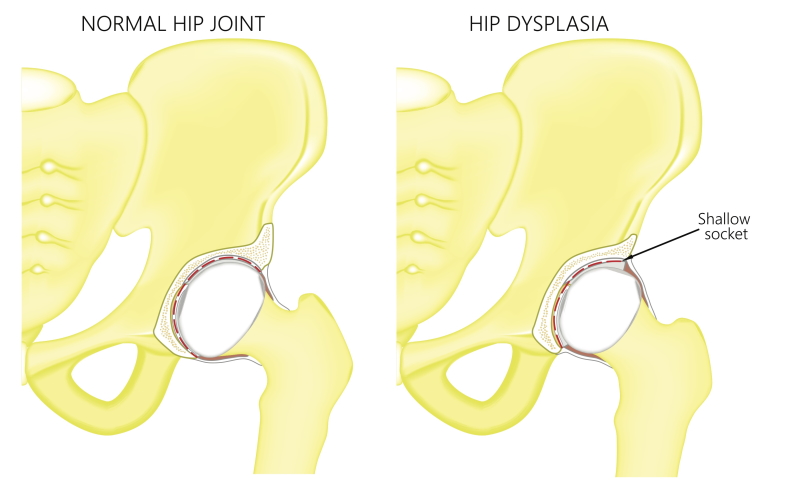Hip dysplasia in adults is a medical term to describe an abnormal hip joint shape. Usually, the socket of the joint is too shallow for the ball. This abnormality forms as a child. But if not picked up, it can present in young adults as activity-related hip pain. So what is hip dysplasia in adults, and what should you do if you live in the UK?
What is hip dysplasia in adults?

Hip dysplasia is a term used to describe the poor containment of the ball in the socket. Usually, the ball or socket does not develop properly in childhood leading to a mismatch in the fit. As a result, excess movement occurs between the ball and socket, producing shearing and potential damage.
In addition, up to 50% of adults with hip dysplasia have a condition called hypermobility. This means that the ligaments and joint capsule are looser than average. All in all, these more flexible structures lead to a more significant head movement within the socket.
The increased movements and stresses on the joint lead to greater abnormal forces on the joint. If left unchecked, these forces lead to pain, reduced function, and early arthritis. Think of a car tire. If not aligned properly, the tire wears down prematurely.
Symptoms of hip dysplasia in adults
Usually, people experience intermittent pain with activity around the hip or groin. Sometimes, pain can be felt in the buttock, thigh, or knee. Pain is usually better with rest. More severe symptoms include clicking or catching, limping, or a feeling that the hip will give way.
One of the challenges of this condition is that not all people have the same symptoms. Also, hip dysplasia often masquerades as tight muscles. So, most are not diagnosed until late, meaning more significant damage to the hip joint will be more likely.
How to diagnose hip dysplasia in adults?

A simple plain X-ray is all that is required to diagnose hip dysplasia. We look at certain angles to measure the coverage of the ball in the socket. First, we use the lateral center-edge angle – an angle less than 18 degrees is defined as severe dysplasia. Second, we use the sourcil angle – an angle greater than 10 degrees means less coverage and significant dysplasia.
3T MRI scan is often performed to take an image of the soft tissues of the pelvis, hip cartilage, and labrum. Just because you have a labal tear doesn’t mean you need surgery.
Many people have borderline cases often missed by doctors who are not looking specifically for this condition.
Treatment Options for hip dysplasia in adults UK
Generally, you have two options for treatment: conservative and surgical options.
Physiotherapy for hp dysplasia in adults
Therapy must correct poor posture, muscle weakness, poor joint awareness, and associated tendon inflammation. Treatment can improve all these factors, including strengthening hip extensors and external rotators, re-education gait, and enhancing body awareness.
Activity modification
Sometimes, we need to consider reducing sport aggravating your hip, such as change of direction sports. Weight loss, a healthy lifestyle, and cross-training (such as swimming but avoiding breaststroke) can all help.
Injections
Sometimes, cortisone injections into the joint can help reduce pain and inflammation for a short time. Also, pain relief from an injection proves that pain relief comes from the joint and not other structures outside the hip.
Surgery
Usually, surgeons advise on an operation if conservative treatments fail to settle symptoms. The gold-standard procedure is POA or Peri-acetabular osteotomy. Often, we recommend this procedure in people with hip dysplasia without arthritis. However, if arthritis has developed, then it’s often too late. It’s a large operation that involves shifting the socket to the right place. Then, surgeons use screws to hold the bone in place while healing.
Surgery aims to delay arthritis (up to 20 years in some studies). However, rehab will take at least a year, so it’s a high undertaking.
Surgeons don’t usually advise on keyhole surgery for dysplasia (unlike hip impingement).
The most crucial part of assessing hip dysplasia is the diagnosis. Dr. Masci works with experts in the field of hip dysplasia, so you’ll see the right person at the right time.








Leave A Comment